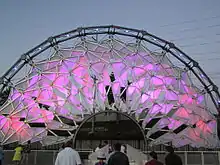
The Hoberman Arch is an architectural element designed by Chuck Hoberman as the centerpiece of the Olympic Medals Plaza in Salt Lake City, during the 2002 Winter Olympics. Following the Olympics, the arch was moved to the Salt Lake 2002 Olympic Cauldron Park at the University of Utah where, along with the Olympic cauldron, it was one of the main features and an important part of Salt Lake's Olympic legacy. In August 2014, the arch was removed from the park[1] and placed in storage, where 29 pieces were stolen.[2] A restored arch was placed on display alongside the exit road of the Salt Lake City International Airport in August 2023.
Design and history
The arch is a semi-circular aluminum structure, which opened like the iris of a human eye.[3] It was designed by to be used as a mechanical curtain for the Olympic Medal Plaza's stage. The design was inspired by Utah's natural stone arches, such as Delicate Arch. At the time of its construction, the arch was the largest unfolding structure in the world.[4]
It took Hoberman four months to design the arch (with support from Buro Happold). Specialized knuckle assemblies, which allowed the arch to expand and contract, were fabricated by Hudson Machine Works in Brewster, NY. These were paired with the arch's structural components and pieced together in its entirety by Scenic Technologies of New Windsor, New York, [5] who spent an additional four months in constructing the arch in their warehouse in New York. It was then disassembled and then trucked to Utah, being reassembled in January 2002, and unveiled to the public and media by the Salt Lake Organizing Committee (SLOC), on January 25, 2002.[3]
When installed at the medal plaza, it would open to reveal a large 3D sculpture of the 2002 Olympic logo and a second Olympic cauldron, known as the Hero's Cauldron. The stage hosted award ceremonies, where the athletes received their medals, and was used as a concert venue during the Olympics, hosting many performing artists including Creed, Brooks & Dunn and the Dave Matthews Band.
After the games

Following the Olympics, plans to install the arch at a park setting were developed. Some people wanted the arch to be used in an amphitheater or some kind of concert venue, possibly at downtown's Gallivan Center or Pioneer Park. But because the arch was a symbol of the 2002 games, the United States Olympic Committee put restrictions on possible future locations for the arch.[6] Because of these restrictions, and a lack of consensus on other options, SLOC announced plans, on December 5, 2002, to install the arch at the Salt Lake 2002 Olympic Cauldron Park.[7]
On July 30, 2003, the arch was lifted onto its new base at the park using 3 cranes.[8] The arch was located just outside the park's southern fence and was partly open which allowed visitors to walk through it, while at night the arch was lit with multicolored lights. The arch was removed from the park in August 2014.[1] On December 6, 2014, 29 pieces of the arch were stolen from an impound lot where it had been stored.[9][10][11] after which the remaining pieces were moved to an undisclosed location.[12]

On August 29, 2023, the restored arch was unveiled alongside the exit road of the Salt Lake City International Airport. The arch sits atop a new 10–12 foot high base, which includes the 2002 Olympic and Paralympic logos and wording memorializing Salt Lake City as the 2002 host of the games. The reconstruction cost $3.79 million and was completed under the direction of artist Gordon Huether.[13][14] The installation does not allow the arch to open and close, but does provide lighting at night.[12] The restoration required newly fabricated pieces[15] to replace those that had been previously stolen.
Structure and mechanism
The arch is 36 feet (11 m) tall, 72 feet (22 m) feet wide, and weighs 31,000 pounds (14,000 kg)[3] It is made up of 4,000 individual pieces put together as 96 connected panels and are connected with 13,000 steel rivets.[5] The 96 panels vary in size, but the largest are 9 feet (2.7 m) tall and 5 feet (1.5 m) wide. The panels are also translucent which allowed light from behind to be seen and echoed the 2002 Olympic theme Light the Fire Within. Two 30-horsepower motors controlled eight separate cables which pulled the mechanical curtain open in about 20 seconds.[3] When the arch was fully opened it had folded up into a 6 feet (1.8 m) ring, which framed the stage. It was designed to open and close like the iris of an eye.[16] During the Olympics, it was included in the every evening medal ceremony and when opened, revealed the second Olympic cauldron.[17]
Because of the potential of strong storms during the games, the arch was built to operate in extreme weather, including up to 70-mile (110 km) -per-hour winds.[3]
References
- 1 2 Richards, Mary (August 1, 2014). "Olympic arch leaving Rice-Eccles Stadium". Salt Lake City: KSL-TV. Retrieved August 1, 2014.
- ↑ Barber, Shaelyn (March 2, 2018). "Barber: Treatment of Hoberman Arch Displays Irresponsible Handling of Olympic Legacy". The Daily Utah Chronicle. Retrieved February 9, 2022.
- 1 2 3 4 5 Brandon Griggs (January 26, 2002). "Space-Age Arch Will Serve as Medals Plaza Curtain". Salt Lake Tribune.
- ↑ "World's Largest Unfolding Arch To Form Centerpiece Of Winter Olympics' Medal Plaza" (Press release). Buro Happold. November 5, 2001. Archived from the original on December 2, 2008. Retrieved November 11, 2010.
- 1 2 Peter Thunell (January 26, 2002). "Olympic arch takes a bow". Deseret News. Retrieved November 10, 2010.
- ↑ Heather May (November 14, 2002). "Oly Hurdle Trips Gallivan Center - Branding concerns may squelch arch deal". Salt Lake Tribune.
- ↑ Mike Gorrell (6 December 2002). "Arch Would Anchor U. Olympic Legacy". Salt Lake Tribune.
- ↑ Lisa Riley Roche (July 31, 2003). "Hoberman arch installed at the U." Deseret News. Retrieved November 10, 2010.
- ↑ Stephen Hunt (December 8, 2014). "Pieces of Hoberman Arch stolen from Salt Lake City impound lot". The Salt Lake Tribune.
- ↑ Christopher Smart (November 13, 2014). "Olympic icon is stored like scrap at Salt Lake City impound lot". The Salt Lake Tribune.
- ↑ Smart, Christopher (January 14, 2015). "Hoberman Arch: Will it ever rise again?". The Salt Lake Tribune. Salt Lake City. Retrieved September 2, 2023.
- 1 2 Apgar, Blake (August 29, 2023). "How the Hoberman Arch was restored from buckets of bolts to its Olympic glory". The Salt Lake Tribune. Salt Lake City. Retrieved September 2, 2023.
- ↑ Roche, Lisa Riley (August 29, 2023). "Here's the new home for an 'iconic image' from Utah's 2002 Olympics". Deseret News. Salt Lake City. Retrieved September 2, 2023.
- ↑ "The Hoberman Arch Finds a Permanent Home at SLC International" (PDF) (Press release). Salt Lake City: Salt Lake City International Airport. August 29, 2023. Retrieved September 2, 2023.
- ↑ "Hoberman Arch restored and installed near SLC Airport". yesco.com. YESCO. November 22, 2023. Retrieved December 3, 2023.
- ↑ Smart, Christopher (August 25, 2015). "Where, oh where, is the Hoberman Arch?". The Salt Lake Tribune. Retrieved February 9, 2022.
- ↑ "Olympic Arch – Hoberman Associates". Retrieved February 9, 2022.